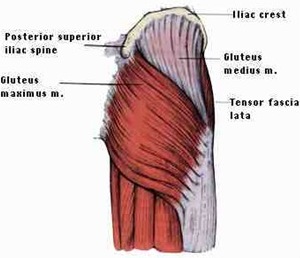Our bones should us up and our muscles should move us. If the bones fail to hold us up as designed muscles step in to help keep us upright. This need for muscles to do jobs outside of their pay grade is responsible for a good percentage of the back pain that people smart from. The whole body suffers for any postural imbalances but some muscles due to location and importance struggle more than others.
- The gluteus maximus is an extensor muscle that runs down the leg from the pelvis to both the leg and the shin via its connection into the IT band, or iliotibial tract.
- The tensor fasciae latae is a small muscle connected into the IT band that, as its name implies, tenses the outer (latae) fascia.
The gluteus maximus and the IT band share some function but are also are meant to accomplish very different actions. Complications arising from poor posture and muscle imbalance often render both the gluteus maximus and the tensor fasciae latae inoperable or at least seriously diminished in their capacity to function as designed.
- The tensor fasciae latae, as well as tensing the outer fascia, also pulls the leg sideways and helps with internal rotation turning one leg toward the other.
- The gluteus maximus, as well as extending the leg helps to stabilize the pelvis, internally rotates the hip from its top half and externally rotates the leg from its lower part.
My writing often returns to the dilemma of the tucked pelvis which forces the thighs forward from their natural home under the hips. Once this happens both gluteus maximus and the tensor fasciae latae are basically muted in their ability to work correctly. The tensor fasciae latae which should rotate internally is instead pulled into constant external rotation due to the tucked pelvis and poorly aligned legs. The tuck of the pelvis that forces the thighs forward also turns the gluteus maximus on and unless the pelvic alignment and leg position change it will stay turned on. This on position affects the tensor fasciae latae and IT band pulling it back into chronic external rotation which like any imbalance can have far reaching consequences.
The gluteus maximus which should play many small parts to assist in the function of the lower extremity and trunk to go along with its lead role as extensor of the leg is forced instead to work with an unhappy quadriceps muscle to hold the body upright.
If you grip your butt both the gluteus max and the tensor fasciae latae will be improperly aligned and dysfunctional. Change the way you walk and stand and you can change the dysfunctional relationship of the gluteus maximus and the tensor fasciae latae.


